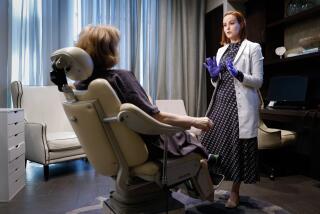Breast Enhancement in the Privacy of Your Own Home
- Share via
The first night she pulled out her new breast enhancement system, a motorized contraption with large, clear plastic domes resembling something only a space-age sex symbol might wear, Linda Langer wondered aloud: “What am I doing ?”
The new vacuum-based system, known as Brava, is worn beneath a large zip-up sports bra at least 10 hours a day for a minimum of 10 weeks. It isn’t for the weak of will.
But nearly two weeks into the regimen, Langer is a believer. “I definitely see a change,” she says. “My breasts are much fuller and they’re not saggy.”
The brainchild of Miami plastic surgeon Dr. Roger K. Khouri, Brava has no national advertising campaign but is catching on through word of mouth. Since March 26, when the product went on sale, more than 1,000 women have been fitted, even though so far the system is sold by only 200 U.S. doctors--for $2,500 each.
Early results, which claim an average gain of less than a cup size, look promising. But other doctors are carefully watching the trend, sensitive to the breast being a delicate, disease-prone organ. Some are concerned about the lack of long-term data--and whether any increase in breast size will actually hold up over time.
Khouri insists the program is safe--and effective. The vacuum pressures, he says, exert a constant pull on the breasts, stimulating reproduction of the breast’s glandular and fat cells. He says he based his work on the tissue expanders that stretch skin and fat for breast cancer patients being fitted with implants. Khouri also cites bone-lengthening devices that use pressure to stimulate growth of new tissue, nerves, muscle and bone.
He even submitted the device to the federal Food and Drug Administration for marketing approval. But the agency considered the system “very low risk” and decided against regulating it. The FDA didn’t review its effectiveness.
Khouri published results on 17 women in the June 2000 issue of the peer-reviewed journal Plastic & Reconstructive Surgery, including tissue growth verification by magnetic resonance imaging and core biopsies. He also has unpublished findings on 200 women he’s followed more than two years.
Dr. William Shaw, chief of plastic and reconstructive surgery at UCLA, has kept tabs on Khouri’s work and believes the device is safe.
“Basically, it’s fairly innocuous,” said Shaw, a friend of Khouri’s with no financial interest in Brava.
Shaw said Khouri has made “a reasonable case” for the supporting science. But he remains unsure how much additional breast volume may be coming from new cells and how much from swelling of existing cells. “That’s the part that still requires more time to figure out.”
Dr. Susan M. Love, a breast cancer surgeon and author of the bestselling “Dr. Susan Love’s Breast Book,” was “pretty impressed” by Khouri’s work on the system, which he began developing in the 1990s when silicone breast implants came under fire.
“If you put this on the list of all things people might do to increase their breast size, this is probably less dangerous than a lot of them,” she said. “Short-term it doesn’t look like it’s doing any harm.
“Women just have to realize we have no idea long-term. It hasn’t been used in that many people.”
Said a skeptical Dr. Susan Downey, an associate professor of plastic surgery at USC: “I just don’t think it will be permanent .... I’d like to see what happens over time. Maybe I’m wrong.”
Doctor Believes Size Gains Are Permanent
Khouri believes the size gains are permanent, although as with non-Brava-induced breast tissue, overall weight gain or loss plays a role. But, he added, the increase doesn’t change a woman’s mammograms because it preserves her natural proportion of fatty and glandular tissue.
The ideal candidate is 18 to 40 years old, who either has small breasts or who is looking to perk up breasts that have shrunk and sagged after breast-feeding (doctors caution it can’t do much for extreme sagging).
The system is not for a woman who is breast-feeding or pregnant, has extensive scarring from past surgeries or a history of breast disease or cancer. It probably isn’t right for a woman with extremely tender breasts.
During the first days of wear, breasts plump up for a few hours as fluid is drawn into them. But over weeks, the breasts gain volume as new cells grow, Khouri says. Although the device doesn’t cause pain, it can cause an uncomfortable pulling sensation.
After about eight weeks, the breasts hit their peak: an average increase of 100 cubic centimeters (slightly less than a cup size). Although they may enlarge more during the final two weeks of the recommended 10-week course, they rebound slightly.
Khouri says Brava can take a woman with a AA cup to an A; an A to a B; or a B to a C. Larger breasts don’t get the same gain and would be too difficult to accommodate in the already-large domes.
Langer, 40, of Los Angeles thinks she’s well on her way from a 34B to the 34C she hopes to reach after 10 weeks (longer if she fails to comply with the 10-hour daily minimum).
Curbing Her Social Life
In the meantime, Brava is curbing her social life because she has to be home by 8 p.m. to have sufficient time to strap the device on, hook it up and keep it running while she tries to sleep.
With an alarm system that lately has been going off about three times a night--whenever her movements break the domes’ vacuum seal, she’s suffering from lack of sleep.
She’s also been forced to change many habits. Because she does a lot of writing at the computer, she had to learn to sit “very erect. You can’t slump because you’ll lose the seal.”
Khouri, who began developing the system when he was a reconstructive surgeon at Washington University in St. Louis, acknowledges that the system isn’t for everyone. “This is for the woman who is disciplined, who knows what delayed gratification means, who is willing to work toward getting something that’s worth getting,” he says.
But Langer, who is dead dsseet against breast implant surgery, finds the sacrifices worth it.
“I don’t believe in unnecessary surgery. And I also don’t believe in foreign particles implanted in your body if you don’t need them.”
Brava is betting that many other women are feeling the same way. The company sees an untapped market of 16 million U.S. women unhappy with their natural breast size, only 1% of whom would shell out the $5,000 to $7,000 to undergo implant surgery (and gain up to three times more breast size than with Brava).
One of the Los Angeles-area physicians trained in the use and monitoring of the system is Dr. Steven Teitelbaum, a Santa Monica plastic surgeon.
Teitelbaum warns his patients that a significant number of Brava test subjects dropped out of the clinical trials “because it’s cumbersome, it’s a total pain in the derriere and it’s a major commitment.” But, he stresses, the proof is in the before-and-after photos.
Since mid-May, Teitelbaum has fitted nearly 20 patients for the Brava domes, which come in eight sizes. There are narrow and wide versions of the small, medium, large and extra-large domes.
Among them is his receptionist, Monica Ayala, 25, who has just begun wearing Brava in hopes she’ll grow from a 34B to a 34C.
“It’s not that I’m not satisfied, but I always wanted to be a size bigger. It might not make me an actual C, but it will make me a full B,” said Ayala. “One of my concerns was being too tender. I’m a little concerned about that, but not enough not to do it.”
Although Khouri says he would prefer to have only plastic surgeons prescribing the system because they are so familiar with the structure of the breast, Brava also has been targeted to ob-gyns and dermatologists. A few doctors in other specialties also have undergone company-required training before selling it. Prospective wearers must undergo screening for suitability and breast health.






